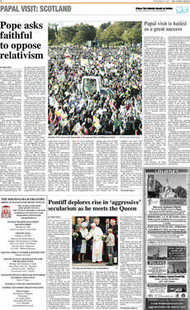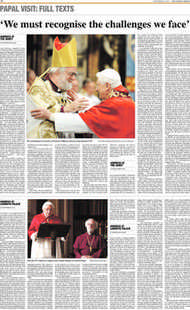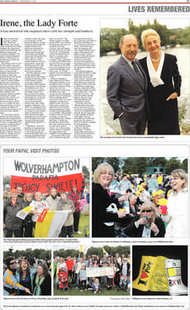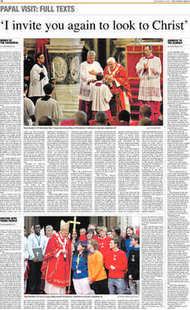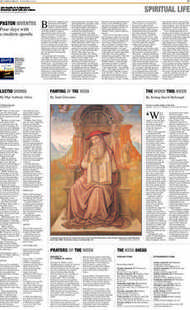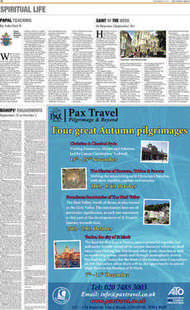Page 6, 24th September 2010
Page 6

Report an error
Noticed an error on this page?If you've noticed an error in this article please click here to report it.
Tags
Share
Related articles
There Will Be No Joint Prayer At Assisi, Says Official
Congregation Ends With Promise Of Fidelity To Pope
Catholics Kneel For Eucharist From Pope
Benedict Xvi Hails Reason During Visit To Mosque
Benedict Xvi And Patriarch Pray At Vatican
Pope Prays For John Paul Ii's Assistance
Leaders pray before the tomb of St Edward
BY CINDY WOODEN AND MARK GREAVES
POPE BENEDICT XVI and the Archbishop of Canterbury, Dr Rowan Williams, knelt together before the tomb of an 11th-century king on Friday after affirming the need for Catholics and Anglicans to give a united witness to society.
St Edward the Confessor, who is buried in Westminster Abbey, reigned five centuries before the Reformation.
The Pope and Dr Williams paid homage to him during an ecumenical prayer service last Friday evening after a 30-minute private meeting and two speeches at Lambeth Palace.
It was the first time a pope had ever visited Westminster Abbey, which until 1540 was home to a community of Catholic Benedictine monks.
The service was attended by Methodists, Presbyterians, Orthodox priests, and the Catholic Bishops’ Conference of England and Wales.
The two leaders venerated the St Augustine Gospels, the oldest illuminated Latin Gospel book in existence, thought to have been brought to England by St Augustine in the sixth century.
Dr Williams, in his address, said that Christians in Britain look back with “fervent gratitude” to 597, “when St Augustine landed on these shores”.
He paid tribute to the influence of St Gregory and St Benedict. The latter, he said, had “opened up for the whole civilisation of Europe since the sixth century the possibility of living in oy and mutual service, in simplicity and self-denial, in a balanced pattern of labour and prayer in which every moment spoke of human dignity fully realised in surrender to a loving God”.
In today’s society, he said, “we can see the dehumanising effects of losing sight of Benedict’s vision”.
Dr Williams also praised Benedict XVI’s “profound and eloquent encyclicals”, which he said had “challenged us to hope both for this world and the next”.
Pope Benedict, in his address, said he was grateful for his welcome and described his visit as a “pilgrimage”, by the Succes sor of St Peter, to the tomb of St Edward the Confessor. He said King Edward was “a model of Christian witness” and “an example of that true grandeur to which the Lord summons his disciples in the Scriptures we have just heard: the grandeur of a humility and obedience grounded in Christ’s own example”.
He said that Anglicans and Christians had made “remarkable progress” over the last 100 years towards Christian unity.
“At the same time, however, we remain conscious of how much yet remains to be done,” the Pope said. “In a world marked by growing interdependence and solidarity, we are challenged to proclaim with renewed conviction the reality of our reconciliation and liberation in Christ, and to propose the truth of the Gospel as the key to an authentic and integral human development.
“In a society increasingly indifferent or even hostile to the Christian message, we are all the more compelled to give a joyful and convincing account of the hope that is within us, and to present the Risen Lord as the response to the deepest questions and spiritual aspirations of the men and women of our time.” At the same time, Pope Benedict said, the desire to present a united witness cannot mean that Christians take short cuts to unity.
He said: “Fidelity to the word of God, precisely because it is a true word, demands of us an obedience which leads us together to a deeper understanding of the Lord’s will, an obedience which must be free of intellectual conformism or facile accommodation to the spirit of the age.” As the Pope and the archbishop processed out of the abbey, the congregation erupted into spontaneous applause. Mgr Guido Marini, the papal master of ceremonies, guided the Pope gently down the steps of the sanctuary.
Mgr Mark Langham, the former administrator of Westminster Cathedral and now an official at the Pontifical Council for Promoting Christian Unity, said the service at Westminster Abbey represented a “rallying call” for Christians.
He said: “It was a strong challenge that complemented what the Pope said in Westminster Hall. In Westminster Hall he stressed the role of religion in public life, and in the Abbey the message was that we have to do this together. The visual signifi cance was also powerfully moving: to see the sign of peace, the Gospels and praying together. Ecumenism isn’t just about theology – it works at every level. This is going to have a strong effect on the ecumenical scene.” Outside the abbey were a small group of Protestant protesters holding signs that said: “No Popery” and “The Pope is the Antichrist”. They were greatly outnumbered by a crowd of supporters cheering and waving flags, many of whom had waited for hours.
blog comments powered by Disqus



